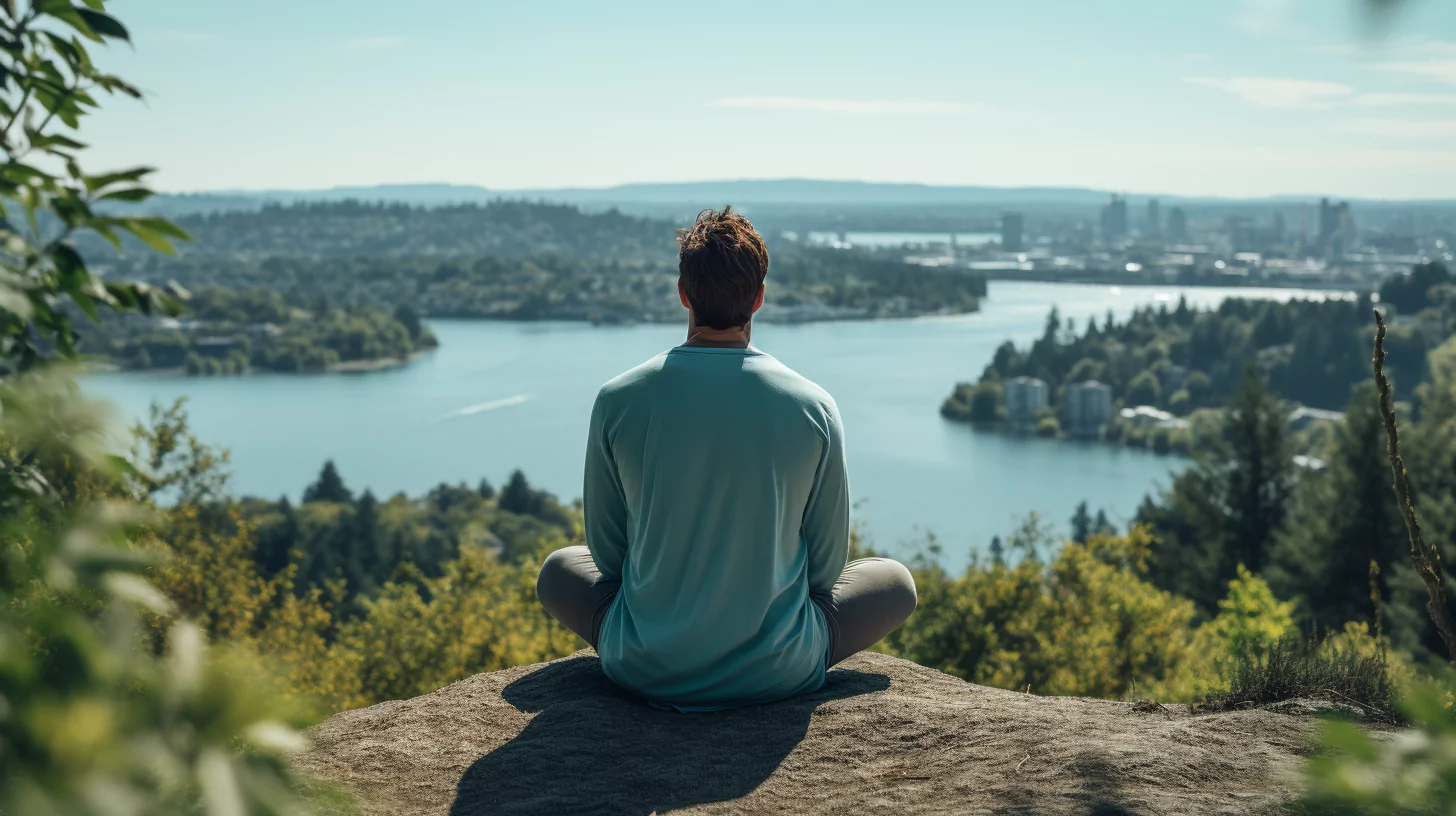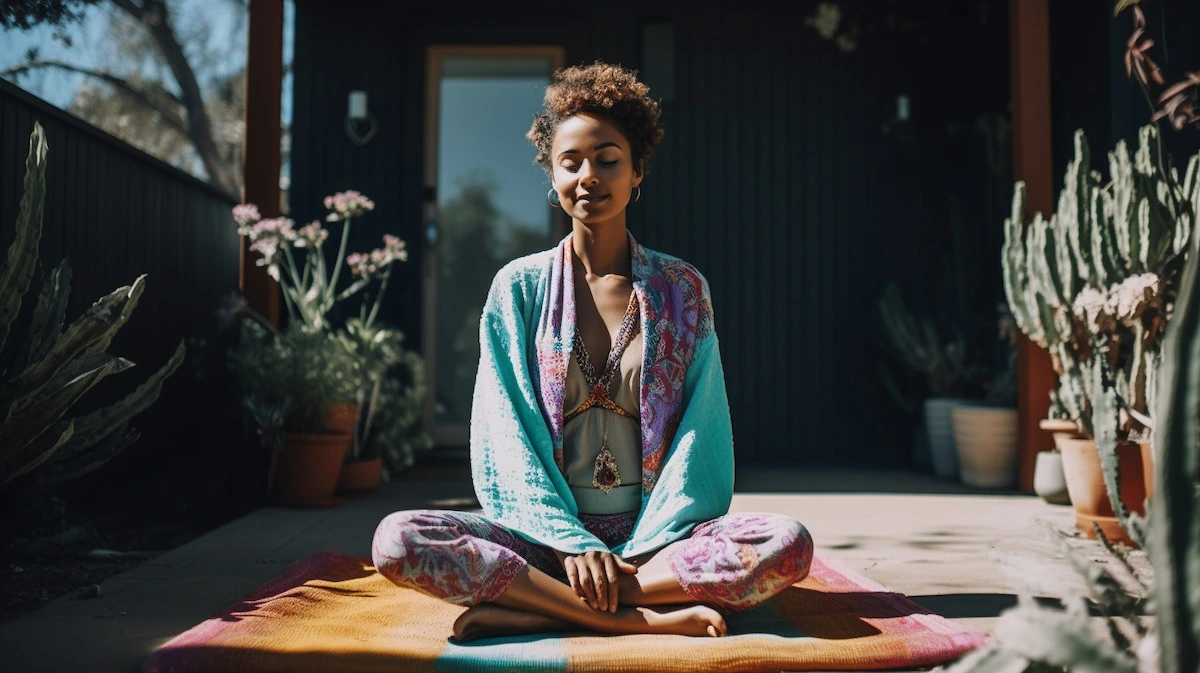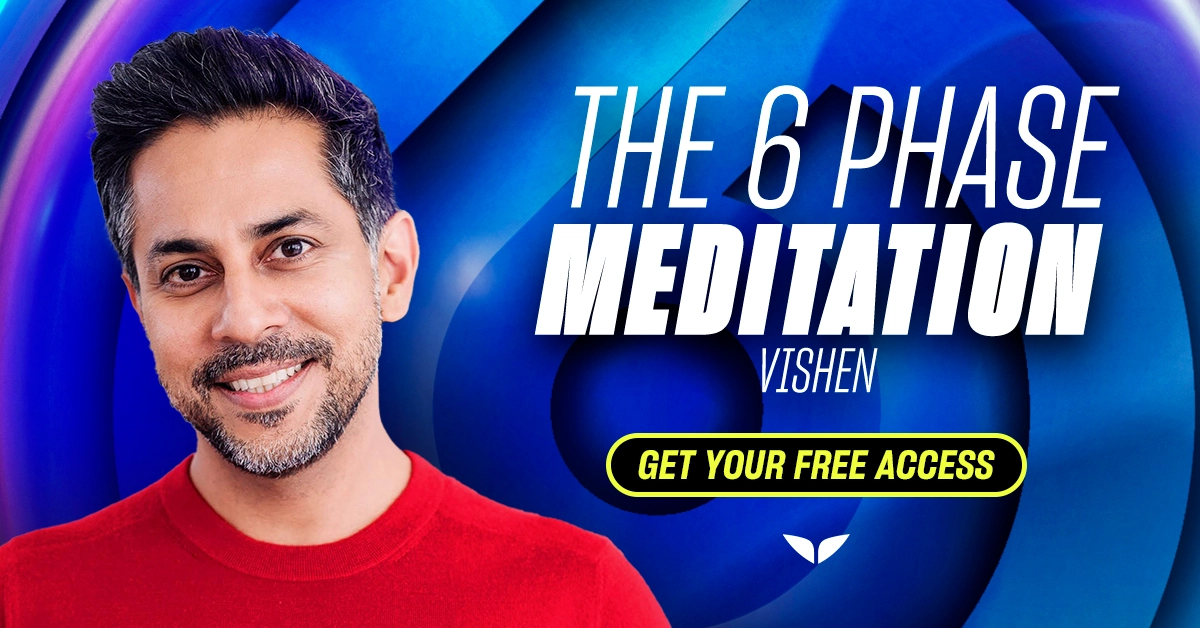When you think of meditation, do you imagine a monk sitting in a cave for hours at a time? Do you feel that it is challenging, tedious, or unattainable for a modern human being?
What if all you know about it are myths or limiting beliefs holding you back from unlocking your potential and becoming better in life?
The truth is, meditation can be effortless when you know what it is and what it’s not. And here’s a little secret: You don’t need to be a devoted monk to practice meditation. But you can meditate like a monk and elevate your spiritual life and other aspects of your human experience.
What is meditation?
Meditation is an ancient practice that trains your awareness, focus, compassion, and mindfulness. This term refers to many meditation techniques to help you integrate your mind and body.
Sadghuru, mystic of our times and trainer of Mindvalley’s A Yogi’s Guide to Joy Quest, calls meditation “inner technologies”—specific ways of bringing all human systems in alignment.
He explains that most people are unhappy or unhealthy because their physical, mental, and energy bodies are not aligned.
Meditation is the technology of keeping these three bodies constantly aligned so that joyfulness is not an accidental happening; joyfulness becomes a normal condition, a natural way of living for you. — @SadhguruJV Share on XIn essence, it’s a powerful tool for spiritual growth as it takes you beyond the limitations of body and mind.
Why people meditate
Ask anyone who’s practiced meditation for years why they meditate, and they’ll happily tell you it’s one thing in life that they can rely on to make them feel good. When meditation becomes a habit, it becomes a reliable source of peace and tranquility.
Meditation is a respite for many people with high-pressure lives. Celebrities, for example, live extremely hectic lives—they face intense pressure from being in the spotlight, and their work hours are often draining.
Many are increasingly incorporating meditation as an essential part of their lives. And here’s what some familiar faces have said about their meditation practice:
- “Meditation is a lifelong gift. It’s something you can call on at any time.” — Paul McCartney
- “Meditation is all about the pursuit of nothingness. It’s like the ultimate rest. It’s better than the best sleep you’ve ever had. It’s a quieting of the mind. It sharpens everything, especially your appreciation of your surroundings. It keeps life fresh.” — Hugh Jackman
- “It feels good. Kind of like when you have to shut your computer down, just sometimes when it goes crazy, you just shut it down, and when you turn it on, it’s okay again. That’s what meditation is to me.” — Ellen DeGeneres
Here’s what some of the most renowned meditation teachers and practitioners say about meditation:
- “I teach meditation to people because they can’t sit in one place. You have to teach them something to make them sit.” — Sadghuru, mystic of our times and trainer of Mindvalley’s A Yogi’s Guide to Joy Quest
- “Your right brain is the router that connects you to Source, and your meditation practice allows you to utilize this router. If you meditate twice a day, you’re strengthening your connection with the divine.” — Emily Fletcher, leading meditation expert and trainer of Mindvalley’s The M Word Quest
- “When you meditate, your brain produces pleasure neurochemicals and your body becomes accustomed to the wonderful sensations they bring. Isn’t it a great way of starting your day?” — Dawson Church, neuroscience researcher and trainer of Mindvalley’s Mystic Brain Quest
- “Practicing meditation creates love, compassion, peace, and kindness. When you meditate every day, you build relationships with your thoughts and feelings, and you can change them intentionally.” — Gelong Thubten, Buddhist monk and trainer of Mindvalley’s Becoming More Loving Quest
- “Dynamic meditation is one of the most powerful tools you can learn to navigate the modern world and make it the better place for everyone.” — Vishen, founder of Mindvalley and author of The 6 Phase Meditation Method
The ancient practice of meditation has become a new norm for many people because it creates tangibly positive changes in their lives.
At the very least, it teaches them to slow down and become more aware of their inner world.

The benefits of meditation for beginners
According to science, meditation and mindfulness practices may have various health benefits and help people improve their quality of life.
Here are some of those benefits:
- Reduces pain. The brain has natural pain-reducing chemicals called opioids. Many pain-relieving medications trigger this chemical to flood the brain. Unfortunately, this has devastating side effects like addiction and withdrawal. Meditation, on the other hand, reduces pain without releasing these chemicals.
- Reduces blood pressure. Hypertension, or high blood pressure, is a deadly condition. Keeping your blood pressure in check is critical for good health. It can prevent heart attacks, strokes, and heart disease. Meditation is one of the best things you can do to keep your blood pressure in check.
- Eases symptoms of anxiety and depression. Anxiety and depression plague our world, and scientists are desperate for a cure that doesn’t come with many side effects. Nearly fifty studies later, researchers have come to a solid conclusion: meditation, without a doubt, alleviates anxiety and depression.
- Helps you quit smoking (and other bad habits). Everyone knows smoking is hazardous. Study after study has proven that smoking is one of the worst things you can do for your health, yet many are addicted with no hope of quitting. Forget patches, medication, or trying to quit cold turkey. Getting in the habit of meditation will give you nearly a 90% chance of stopping smoking and never relapsing.
- Makes you more spiritual and improves your life. Connecting with your higher self and something bigger than yourself always results in a positive experience. It’s been scientifically studied and proven that meditation improves your quality of life.
- Improves your sex life. Surprisingly, meditation and sex life are intertwined. According to Emily Fletcher, one of the world’s leading experts in meditation, the more you start meditating, the more you’ll start accessing the bliss within, and you’ll have more of it to give to your partner and your fulfillment.
On top of that, meditation gives you a sense of place in the world and helps you cope with life’s daily stressors.
5 best guided meditation examples
Guided meditation is a great way to build your practice. There are various techniques you can choose from. Here are the go-to meditations for beginners:
1. Mantra meditation
One way to focus your mind is to use mantra meditation, a practice that utilizes mantras as an object of focus for your mind. It can be a word, sound, syllable, or phrase that you can sing, chant, hum, or repeat as you meditate.
Due to specific sound frequencies, mantras elevate your state on multiple levels and promote greater mindfulness.
2. Mindfulness meditation
You can train your mind to stay present in the moment and cultivate awareness, using the mindfulness meditation technique.
Most mindfulness practices focus on your breath, bodily sensations, and thoughts. The ultimate goal is to make mindfulness your default state.
3. Chakra meditation
To target blocked chakras, try chakra meditation. It’s designed to help you cleanse, clear, and balance your energy centers.
You can meditate on all chakras, moving from bottom to top. This is how you will keep them aligned and balanced to ensure your overall well-being.
On top of that, according to Anodea Judith, leading chakra expert and trainer of Mindvalley’s Chakra Healing Quest, balanced chakras can help you manifest your wildest dreams.
4. Meditation for anxiety
If you suffer from anxiety, meditation for anxiety relaxes your body to release stress.
According to Paul Mackenna, hypnotherapist and trainer of Mindvalley’s Everyday Bliss Quest, when you experience stress for too long, your body gets used to it, becoming your background stress.
Learning to relax on demand can fight anxiety and dramatically improve your life.
5. The 6 Phase Meditation
The 6 Phase Meditation isn’t quite a meditation. According to Vishen, founder of Mindvalley and author of The 6 Phase Meditation Method, unlike traditional meditation that focuses on clearing your mind, this method teaches you to use your mind to deliberately solve the problems you might face and unleash your potential.
“It’s a form of transcendent practice that allows you to go into your mind and optimize the very act of being human,” he explains.
It consists of six thought exercises that help you grow, transform, and make a bigger impact in the world.
Curious to try it out? Here’s The 6 Phase Meditation guided by Vishen:
How to start meditating in 7 steps
Are you eager to start meditating but have no idea where to start? Here are eight steps to get you started.
1. Pick your practice time
The best way to start a meditation habit is to practice every single morning. Morning meditation is a great way to start your day. And it’s much easier to convince yourself to do something first thing in the morning than after a long, hard day.
2. Schedule your practice
You will take it more seriously when you schedule your practice, just like you schedule your important meetings. Setting your alarm 5-10 minutes before your meditation will give you time to prepare, especially if you are a beginner.
3. Be patient with yourself
If you are someone who pressures yourself to be perfect all the time, meditation is not the time and place for that. Allow yourself room to breathe and practice patience along with compassion for yourself.
4. Practice non-judgment
There is no right or wrong when you meditate. It’s easy to think that being distracted, fidgeting, or having your mind wander are negative experiences. But they are totally natural, and meditation isn’t about fighting or resisting those natural occurrences. It’s about experiencing them and allowing them.
5. Use guided meditations
These are audio tracks where someone walks you through each step of meditation, which is enormously helpful. They do as they say: guide you through a meditation, so you don’t have to think or worry about what to do. You can sit back, relax and follow the instructions.
6. Find a meditation buddy
Everything is easier with a friend. You can practice meditations together and share your experiences, or you can hold each other accountable. We’re more likely to commit to something when we’ve told someone else we would do it.
7. Join a community
Join a group of people committed to meditating. Not only will you find friends who share a common interest, but you’ll also be more motivated to participate when you feel the support of a community behind you.
How to build a meditation practice in 7 steps
For any habit-building, you can follow a series of steps that will make the habit stick.
Forming habits is fairly formulaic. Your brain creates patterns in a very recognizable and predictable way, so if you follow a natural habit-making formula, the habit will be more likely to stick.
Most importantly, you want to take small incremental steps that will eventually have a compound effect. It will also prevent you from getting overwhelmed.
Step 1: Choose your one habit and commit to it
It’s easy to get excited about becoming a happier person. Before you know it, you’ve committed to yoga, meditation, a new diet, and a workout routine. And then, before you know it, none of them are a part of your life anymore.
This is because habits form one at a time. So take it slow.
Commit to meditating every day, and don’t start another new habit for at least 30 days, though depending on your personality, you may want to extend that to 60 days.
Step 2: Attach your habit to an established one
Habits stick better when they become part of an already-established routine. Whatever you do first thing in the morning—brush your teeth, take a shower, go for a walk—attach meditation to your morning routine. Immediately before or after your daily morning ritual, commit to practicing meditation.
Remember, you only need to commit 2–5 minutes at first, then gradually increase that time to something comfortable.
Step 3: Tell someone
Accountability makes us more likely to follow through. Announce it on social media or tell a good friend about your intention. Simply saying, “I am committing to meditating every morning” is extremely powerful for building a habit.
Step 4: Reward yourself
Most people fail to solidify a habit because they don’t find their motivation early on. They start strong with a lot of energy to make good habits, but that initial energy dies out quickly, and in the end, they return to where they started.
You can’t break this pattern without fueling your motivation with a reward. So you want to reward yourself every time you meditate. It will keep you motivated after the initial energy spark dies off.
Step 5: Make meditation part of your self-identity
Instead of thinking of meditation as something you will add to your life, try imagining yourself as a meditator. This tiny but potent perspective shift will become a game-changer. Owning the identity of someone who meditates strengthens and solidifies the habit.
Step 6: Meditate every day
Consistency is key. So you want to meditate every single day. In the first thirty days, there will be times when it feels tedious, but power through.
Eventually, your brain will recognize the habit, and it will become a natural part of who you are and what you do.
Step 7: Use meditation apps
To help track your progress and keep you motivated throughout your habit-building journey, use meditation apps.
You can find a plethora of mindfulness content on the Mindvalley app. These guided meditations help you cultivate a better mindset, achieve self-mastery, increase your performance, and find your purpose in life.
They also include solfeggio frequencies and binaural beats to level up your overall meditation experience and rewire your brain on a subconscious level.

Myths about meditation
When it comes to sticking to your meditation practice, it’s crucial to let go of the myths about it that may be holding you back. So let’s look at these common myths:
Myth 1: Thoughts are your enemies
When you start to meditate, your mind starts to wander. So you struggle to clear your mind, perceiving these thoughts as your enemies.
But your thoughts aren’t your enemies. They allow you to become aware of your thoughts and return to your meditation technique.
In other words, your thoughts and meditation happen at the same time. Instead of making so much effort to clear your mind, you want to enjoy them as a natural part of your practice.
Myth 2: Falling asleep during meditation is bad
Falling asleep isn’t a problem. You’re giving your body rest that’s five times deeper than sleep. As long as you aren’t falling off your chair, you’re doing good enough.
Now, let’s dive into seven simple steps to build your meditation practice:
Becoming better in life
So why meditate in the first place? You aren’t meditating to be better at meditating. The purpose of your meditation practice is to be better in life. And this powerful tool can help you do just that.
Whether you are new to this practice or an advanced meditator, Vishen’s FREE 6 Phase Meditation Quest can take your meditation to a new level.
This meditation course will teach you how to meditate using the power of your subconscious mind to create more magic and joy in your life, increase productivity, find peace, and manifest your goals—all through The 6 Phase Meditation Method.







